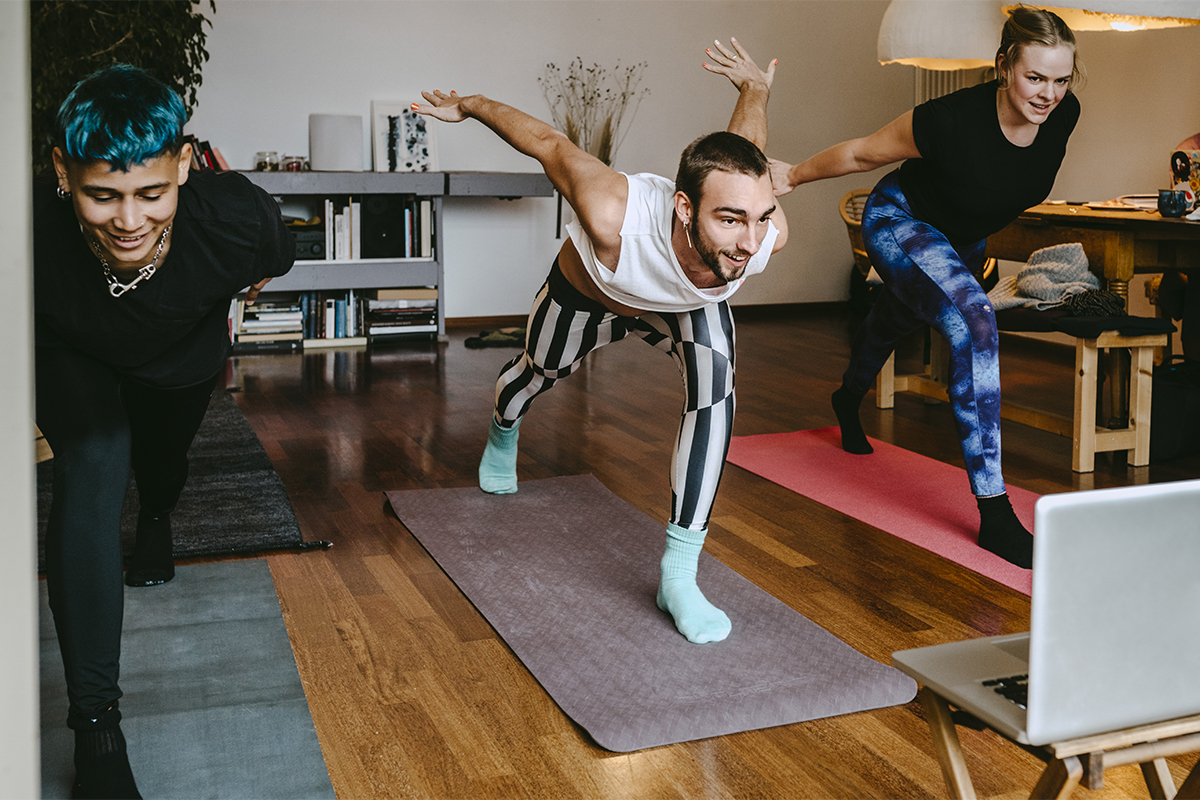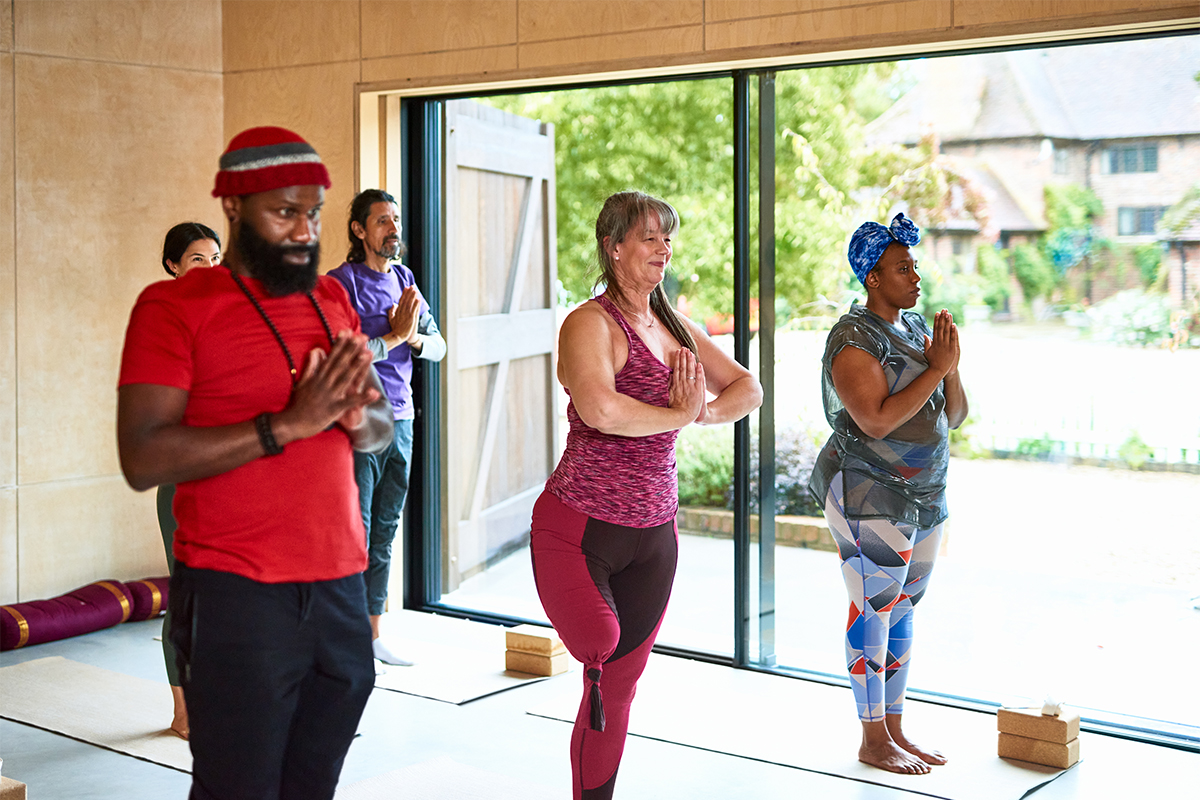If you think about the heyday of step aerobics, you may recall how unusual it would have been to see a man in class. Traditionally, group fitness classes have largely been attended by women. It’s a trend that has been shifting, especially over the past two decades. Formats such as indoor cycling, group strength and kickboxing have improved on gender inclusivity and made the studio feel more welcoming to men, so it’s not uncommon to see more of a mix in a typical class.
But what if you don’t identify as cisgender (someone whose birth sex and gender identity are the same)? Or what if the “mainstream” definitions of the kinds of fitness classes a person “should” take don’t ring true for you? Where would you fit into that choreographed moment? How welcome would you feel in a class where a stark line is drawn down the middle of the room, pitting “he” against “she”? In fact, the opening paragraph of this article underscores an increasingly outmoded way of thinking.
Even if our sincere intentions are to reach as many people as possible through gender inclusivity, we often create experiences that have a strong, strictly feminine or masculine tone in our marketing and staff culture, making portions of the population feel excluded. The LGBTQ+ market (which includes people with a variety of genders and sexual orientations) is the fastest-growing consumer segment in the United States (Oakenfull 2021). With the growing recognition of the diversity in the world, fitness professionals have an opportunity to make wellness accessible and welcoming to everyone.
Reconnecting with Reasons for Gender Inclusivity
If you’re dedicated to serving and helping as many people as possible find pathways to health—and you believe that everyone deserves the opportunity to connect with a community that supports their efforts—then you’re likely open-minded to exploring the concept of gender inclusivity in your teaching and coaching protocols. This goes hand in hand with creating inviting and supportive marketing and branding that ultimately helps our industry serve more people.
It’s a matter of reconnecting with the reasons why you started teaching fitness in the first place.
By creating gender-inclusive environments, you can bring in a greater share of the market, which translates into more customers and higher revenue. If the focus is retaining and growing membership, recognize the LGBTQ+ market has a buying power valued at just under $1 trillion (Schneider & Auten 2018). It’s not just a matter of being an advocate; it’s also good for business!
See also: Creating Inclusivity in Fitness Spaces
Five Tips for Gender Inclusivity

Instead of cuing from a gender-normative perspective, switch to cuing that’s more neutral.
Creating a more inclusive environment in your classes is something you can do immediately. Consider using the following five welcoming solutions to shift your coaching and cuing structure to one that supports and invites all members to your workouts.
1. Cue Anatomically
Instead of cuing from a gender-normative perspective—for example, falling back on stereotypical tropes—switch to cuing that’s not only more neutral, but arguably more accurate.
Many instructors tend to inadvertently use a cuing structure that is strongly feminine or masculine. For example: “Come on class, squeeze that booty!” Many students won’t notice, but some do and say nothing. They also never return. Consider saying something like “Contract your glutes,” which is more neutral.
The human body is the foundation of training, and certified fitness professionals are tested on their knowledge. It’s an important foundational aspect of all programming. Each body has the same basic structure, so it’s fairly straightforward to break down each exercise into three phases: setup, execution and transition. (The setup includes the start position for the exercise.)
Use the five kinetic checkpoints as a blueprint. For standing exercises, cue from the floor up. For ground-based exercises, move from one end of the body to the other, and highlight the mobile and stable muscles and joints. End the exercise in the starting position before transitioning to the next exercise.
For example, if you’re cuing a pushup, the setup would be: “Start in a plank, with your elbows and shoulders over your hands, keeping a line from your ears to your heels.
2. Use Common Imagery
Familiarity aids in the learning process, and regardless of how one identifies, we all have vastly different life experiences. While teaching, strive to use examples and analogies from common, shared experiences. This helps create clear associations, which improves visual connections, movement quality and execution.
For example, when teaching a squat, tell participants to imagine they are sitting back into a chair.
3. Personalize the Experience
In addition to using first names, incorporate words like “you” and “your” to personalize movement cues, making all participants feel like the instructions are directed specifically to them.
For example, to set up a squat, instead of saying, “Stand up tall, stacking ankles, knees, hips, shoulders and ears,” say “Stand up tall, stacking your ankles, knees, hips, shoulders and ears.” When using equipment, say “grab your heavy weights.” Be a party host, and, from beginning to end, make each cuing element about the participant.
4. Use Gender-Neutral Collective Nouns
Build community by using words such as “team,” “family” or “crew.” Groups can also be categorized by timeslot, class format or facility.
For timeslot, try, “Good morning, 8:30 a.m. crew” or “Let’s go, lunchtime team.” Another alternative is to focus on the class format. For example, “Time to ride, cycling athletes!” or “Way to bring it tonight, boot campers!” Or use the facility name to bring everyone together. “Love the energy, Crunch rock stars” or “Orangetheory®, time to earn Splat Points!” These all help build community.
5. Go Beyond the Physical
While exercise primarily focuses on the physical, all fitness professionals are aware—or should be—of additional benefits, including mental, social and emotional. It’s safe to assume that a diverse group of people will have unique motivations.
For example, just because people have larger bodies doesn’t necessarily mean they’re taking class to lose weight. Maybe they simply want to meet other people, listen to motivating music or just have fun! Highlight other benefits such as increased energy, higher levels of self-confidence and reduced stress.
Fitness professionals have the power to create connections and foster inclusivity through words and actions, using movement as the common denominator for every body and every body.
See also: Gender Equity in Fitness: Are We There Yet?
Branding and Staffing Basics

When people sign up for your services, give them the option to share their preferred pronouns.
In addition to paying attention to how you address participants in class, your club’s branding and marketing materials can either invite or repel members. Consider the following suggestions.
Choose gender-neutral colors. Select colors that are energizing, such as bold greens, oranges, blues and reds, and limit the use of traditional feminine (purple/pink) or masculine (black/grey) colors.
Show a variety of body types in marketing materials. While there’s nothing wrong with showing traditionally feminine or masculine people in your photos, it’s a good practice to also include nontraditional body types or ways of dressing. Not everyone wears fitted and gender-specific clothing styles. For people who don’t want to showcase their bodies when they work out, imagine how affirming it would be to see someone on a poster who is neither masculine nor feminine. This simple change can be a huge draw for new members.
Get buy-in from employees. Your staff are the direct contact point to all current and prospective members and are instrumental in respecting and welcoming all genders. If you’re a group fitness manager, it’s important to train staff to make sure everyone is on the same page regarding the drive for inclusivity.
Ask for pronouns. When people sign up for your services, give them the option to share their preferred pronouns, which is a courtesy many people will take to heart and deeply appreciate. Ask staff to review the roster of attendees, and strive to use their preferred pronouns. Empower instructors to introduce themselves by their names and preferred pronouns: “Hi, my name is ____ and I use the pronouns ____ / _____. I will be leading your workout experience today.” This opens up the communication between instructors and members.
Level the lavatory. If your facility can offer an all-genders restroom and changing space, this is a wonderful offering and goes a long way toward helping people feel as if they can use the restroom or change their clothing without feeling uncomfortable.
See also: Inclusivity for Transgender Clients
A Welcoming Space for All
The suggestions presented in this article are building blocks to a broader, long-term strategy for gender inclusivity. A welcome byproduct is that it can also be financially lucrative for businesses and rewarding to customers. Taking these steps can make a huge impact on who feels welcome in your classes and your facility.
The post Classes for the Masses: Gender Inclusivity appeared first on IDEA Health & Fitness Association.